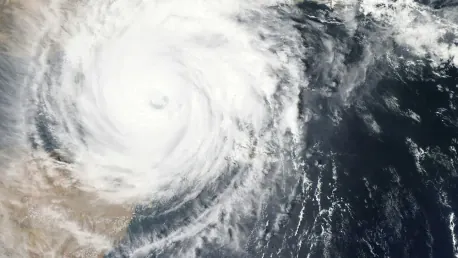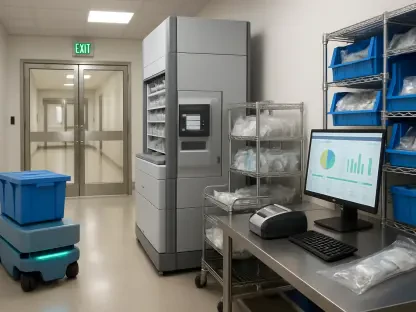The healthcare sector in the United States is currently grappling with a severe shortage of intravenous (IV) solutions, a crisis triggered by the recent disruption of supply chains due to Hurricane Helene. This shortage is causing significant operational burdens on hospitals nationwide as they struggle to maintain critical care services. The immediate cause of this shortage can be traced to the temporary closure of Baxter International’s North Cove facility in North Carolina, a vital production site for IV fluids and peritoneal dialysis solutions. In the wake of this natural disaster, the American Hospital Association (AHA) is urging federal intervention to mitigate the crisis and ensure hospitals can continue to provide essential patient care without interruptions.
Impact of Hurricane Helene on Baxter International
The main driver behind the current IV solution shortage is the temporary closure of Baxter International’s North Cove facility in North Carolina. Baxter International, one of the largest suppliers of IV fluids and peritoneal dialysis solutions in the U.S., was forced to halt production after the facility suffered extensive damage from Hurricane Helene. The storm brought heavy rainfall and a powerful storm surge, flooding the facility and disrupting production lines. This situation has led to an unprecedented strain on hospitals that depend on a steady supply of IV solutions to meet patient needs. With Baxter’s production capabilities severely diminished, healthcare providers are scrambling to find alternatives to manage this critical shortage.
As a direct result of this unexpected event, hospitals that rely on a steady supply of IV solutions from Baxter are unable to secure the necessary amounts to meet patient demands. This has precipitated an urgent need for effective response measures from both the healthcare industry and the federal government. The immediate impact necessitates a coordinated effort to find viable solutions that can alleviate the pressures faced by affected hospitals and ensure that patient care is not compromised during this challenging period. This highlights the interconnectedness of natural disasters and their significant effects on critical healthcare supply chains.
Strains on Hospital Operations
Hospitals across the United States are feeling the pressure from the shortage. In response, many have started to reschedule non-emergency procedures to prioritize the use of available IV solutions for critical care patients. This approach aims to conserve the limited stock at hand and ensure that emergencies can be adequately handled. Healthcare providers are also implementing conservation strategies, such as centralizing the storage of IV solutions and closely monitoring usage rates. Despite these measures, the strain is palpable. In some cases, elective procedures have been canceled altogether, disrupting patient care and causing delays in treatment for those with non-life-threatening conditions. The ripple effect of this shortage is being felt across the entire healthcare system as facilities adapt to the operational constraints imposed by the limited availability of IV fluids.
The broader implications of this shortage are also becoming evident as hospitals navigate the delicate balance between resource management and patient care. While some institutions have managed to mitigate the immediate impact through strict rationing and prioritization strategies, others are encountering more significant challenges. The shortage underscores the critical role that a continuous supply of IV solutions plays in day-to-day hospital operations and reveals the vulnerabilities that exist within the current healthcare supply chain. This crisis serves as a stark reminder of the importance of preparedness and the need for robust contingency plans to address potential disruptions in essential medical supplies.
The American Hospital Association’s Call for Action
In light of the severe shortage, the American Hospital Association (AHA) is advocating for immediate federal intervention. The AHA has urged the Biden administration to invoke the Defense Production Act, which would allow the federal government to direct manufacturers to prioritize the production of IV solutions and other critical medical supplies. The invocation of such emergency powers could significantly ramp up production and expedite the distribution process to address the immediate demands faced by hospitals nationwide. Additionally, the AHA suggests that the Food and Drug Administration (FDA) should officially declare a shortage. This designation would grant healthcare providers additional flexibilities, such as the ability to prepare their own sterile IV solutions in-house and to redistribute supplies more freely among facilities. These adjustments could help to alleviate some of the immediate pressures facing hospitals.
Furthermore, the AHA’s call for action encompasses a comprehensive strategy that includes tapping into international manufacturers, extending the shelf life of nearing or expired IV solutions, and considering regulatory waivers for Medicare and Medicaid rules. By taking these steps, the healthcare sector can create a buffer that ensures a continuous supply of IV fluids and other essential medical supplies. The AHA emphasizes that without swift and decisive federal intervention, the ongoing shortage could deepen, adversely affecting patient care across the nation. This appeal to federal authorities is driven by the urgent need to stabilize the supply chain and support the healthcare infrastructure during this critical period.
Steps Taken by Baxter International
In response to the crisis, Baxter International has begun to resume some shipments of IV solutions. However, the company has had to ration these shipments to prevent stockpiling and ensure a fair distribution of the limited supply. Baxter is working tirelessly to clean and restore its North Cove facility, with temporary bridges installed to facilitate the transport of goods and an ongoing inspection of salvaged inventory. Despite these efforts, the recovery process is slow and complex, and it will take time for production to return to pre-storm levels. Until then, hospitals will continue to face challenges in maintaining adequate supplies of IV fluids.
Baxter’s recovery efforts are part of a broader strategy to ensure a steady flow of essential medical supplies under challenging circumstances. By implementing measures to control distribution and prevent hoarding, Baxter aims to maintain a balanced supply across the healthcare system. However, the company’s recovery is subject to various factors, including the extent of the damage and logistical challenges associated with restoring full production capacities. Baxter’s gradual return to normalcy underscores the complexities involved in restoring critical supply chains disrupted by natural disasters, highlighting the need for resilient infrastructures capable of withstanding such events.
Potential Long-Term Solutions and Strategies
To address the shortage, a range of potential strategies is being considered. One suggestion is to waive the 1-mile rule that restricts the distribution of products across hospital networks, allowing for more flexible sharing of resources between closely located facilities. Another recommendation is to extend the shelf life of IV solutions that are nearing expiration, subject to appropriate safety checks. By implementing these measures, hospitals can optimize the use of existing supplies and minimize waste, ensuring that available resources are utilized efficiently.
Moreover, engaging with international manufacturers to import additional supplies could provide a temporary buffer while domestic production ramps back up. Declaring a national emergency could also offer regulatory relief, such as waiving certain Medicare and Medicaid requirements, to better manage the crisis. These potential solutions highlight the need for a multifaceted approach to address the current shortage and prevent future disruptions. By diversifying supply sources and implementing regulatory flexibilities, the healthcare system can enhance its resilience and better cope with unforeseen challenges.
Additionally, fostering greater collaboration between public and private sectors is crucial for developing comprehensive strategies to mitigate supply chain vulnerabilities. Strengthening communication channels and establishing contingency plans can help ensure a more coordinated response to emergencies. These long-term solutions underscore the importance of proactive measures and forward-thinking policies to safeguard the healthcare system against future shortages.
Broader Implications for the Healthcare System
The U.S. healthcare sector is currently facing a critical shortage of intravenous (IV) solutions, a problem exacerbated by recent supply chain disruptions caused by Hurricane Helene. Hospitals nationwide are encountering significant operational challenges as they strive to maintain essential care services. This shortage is largely due to the temporary closure of Baxter International’s North Cove facility in North Carolina, a key manufacturer of IV fluids and peritoneal dialysis solutions. The production halt has placed an enormous strain on hospitals that rely on these supplies for patient care.
In response to these challenges, the American Hospital Association (AHA) is calling for federal intervention to help alleviate the crisis. They are urging the government to deploy resources and support mechanisms to ensure that hospitals can continue to provide uninterrupted care. Without swift action, healthcare facilities may face increased difficulties in delivering vital treatments. The AHA’s plea underscores the urgent need for a coordinated effort to stabilize the situation and protect patient health across the nation.









